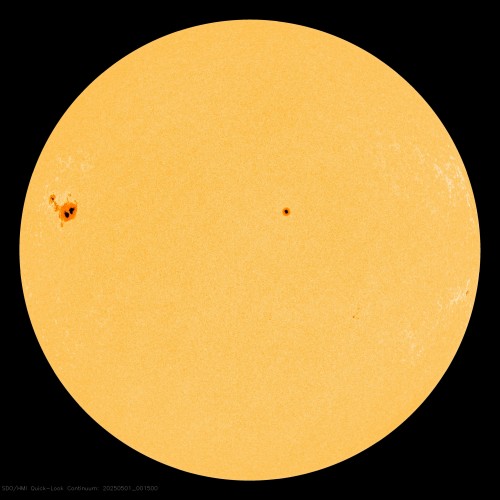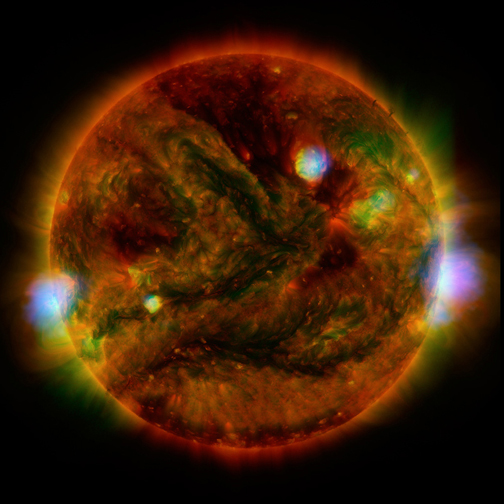Predikce sluneční a geomagnetické aktivity
Solar activity forecast for the period |
March 28 - April 03, 2025 |
| Activity level: | low to moderate |
| X-ray background flux (1.0-8.0 A): | in the range B9.5-C5.0 |
| Radio flux (10.7 cm): | a fluctuation in the range 100-195 |
| Events: | class C (3-15/day), class M (1-10/period), class X (0-1/period), proton (0-1/period) |
| Relative sunspot number (Ri): | in the range 60-150 |
Karolina Knesplova
RWC Prague, Astronomical Institute, Solar Dept., Ondrejov, Czech Republic
e-mail: sunwatch(at)asu.cas.cz
Geomagnetic activity forecast for the period |
March 28 - April 03, 2025 |
| Quiet: | Mar 30 - Apr 1 |
| Unsettled: | Mar 28 - 30 |
| Active: | Mar 28, Apr 2 - 3 |
| Minor storm: | Apr 2 - 3 |
| Major storm: | 0 |
| Severe storm: | 0 |
| Geomagnetic activity summary: |
After the last major storm (at the Budkov observatory, the local K-index reached level 6), we expect geomagnetic activity decrease to unsettled level till Sunday, March 30. |
Tomas Bayer, RWC Prague
Institute of Geophysics of the ASCR, Prague
Department of Geomagnetism
Budkov observatory (BDV)
Geomagnetic activity forecast for the period |
March 28 - April 03, 2025 |
Remarks:
Weekly Commentary on the Sun, the Magnetosphere, and the Earth's Ionosphere March 28 - April 03, 2025
Weekly Commentary on the Sun, the Magnetosphere, and the Earth's Ionosphere – March 27, 2025
Most forecasts, including those from NOAA, have been consistent over the past week that a strong G3-class geomagnetic storm would develop on Sunday, March 23. In fact, a CME was expected to directly impact the Earth. Although the source of the CME was only the M1-class solar flare from AR 4028, even weaker CMEs can produce strong geomagnetic disturbances, especially on days around the equinoxes. In the end, however, paradoxically, 23 March was the relatively quietest day.
However, a large coronal hole caught our attention this week, while we expected that once it reached the central meridian region, the solar wind stream would head directly towards Earth. This is what happened and in the following days, especially on March 26, a G2 class geomagnetic storm developed. The solar wind speed increased from 400 km/s to 700 km/s. On March 27, the increase continued to over 800 km/s (1.8 million mph).
Shortwave propagation conditions were particularly degraded along paths through the higher latitudes of the Northern Hemisphere. Outside of these, there was also a more pronounced decrease in MUF on routes that crossed South America and the South Atlantic where geomagnetic anomalies are located.
While late March and early April are periods with traditionally better-than-average shortwave propagation conditions, this time our expectations will only be partially met. Solar activity is lower than would be consistent with the current phase of the solar cycle - and disturbances are relatively common.
Poznámka:
Informace jsou přebírány z uvedených externích zdrojů a z důvodů přesnosti jsou zveřejňovány výhradně v anglickém jazyce.
Připravované akce
Přednáška "Zpráva o zatmění Slunce 21. srpna"
16. 10. 2017, 19:00 hodin, Zlín
Vyhledávání
Novinky a aktuality
Částečné zatmění Slunce
12.10.22
Částečné zatmění Slunce nastane 25. října 2022 Začátek astronomického úkazu (první kontakt) v 11:14:58 SELČ Hvězdárna bude pro veřejnost otevřena od 11:00 do 14:00 hodiny.
Odešel dlouholetý pozorovatel Slunce
16.02.22
Dne 11. února 2022 nás navždy opustil ve věku 73 let náš kamarád a kolega pan František Zloch, dlouholetý aktivní pozorovatel projevů sluneční aktivity na Astronomickém ústavu AV ČR v Ondřejově a popularizátor nejen astronomie.
Jaký je sluneční cyklus č. 25?
10.02.22
Již dva roky (od prosince 2019) je v činnosti sluneční cyklus s pořadovým číslem 25. Jak to vypadá po srovnání lednových údajů s počty slunečních skvrn a co nás může čekat v budoucnu?











